List of Authors
>>About this blog
Recent blog post
|
[Shitamachi Tom]
December 27, 2013 09:00
It's getting running low this year too. For those who are related to Chuo-ku, various memories will surely be mixed.
 When Christmas is over, we're preparing for the New Year. It's a busy year for cleaning up, preparing New Year's dishes, and busy. And how would you like to spend New Year's Eve? People who are busy preparing for the New Year until the end, those who work during the year-end and New Year holidays, and those who spend a relaxing time ... each day looks back on the year. When Christmas is over, we're preparing for the New Year. It's a busy year for cleaning up, preparing New Year's dishes, and busy. And how would you like to spend New Year's Eve? People who are busy preparing for the New Year until the end, those who work during the year-end and New Year holidays, and those who spend a relaxing time ... each day looks back on the year.
Speaking of New Year's Eve, there are many people who eat "New Year's Eve soba". Originally, "New Year's Eve" means "Setsubun", which means that on this day we prayed for sound health and ate auspicious soba. In the lunar calendar, early spring was the New Year, so the previous day's Setsubun was probably the most important thing. Later, the last day of December became "New Year", and it became established throughout the country with the introduction of the solar calendar. Nowadays, it's a feature of New Year's Eve along with the "bell of night removal".
 Actually, there is another important traditional event on New Year's Eve. This is to visit great exorcism at the shrine. It is an important ceremony that removes everyday filth and entrusts wishes for the New Year together with "Nago Shinohara" on the eve of June. It has been held since the days of Nara and Heian. On this day, we will go through the Chinowa, which will cause trouble, and cleanse ourselves. And they dedicate a doll (persongata) by entrusting them to remove the filth on their behalf. Actually, there is another important traditional event on New Year's Eve. This is to visit great exorcism at the shrine. It is an important ceremony that removes everyday filth and entrusts wishes for the New Year together with "Nago Shinohara" on the eve of June. It has been held since the days of Nara and Heian. On this day, we will go through the Chinowa, which will cause trouble, and cleanse ourselves. And they dedicate a doll (persongata) by entrusting them to remove the filth on their behalf.
In the first place, the meaning of visiting a shrine is to express appreciation for everyday blessing and to remove mistakes and filth of the body. It is said that it is not a sudden wish.
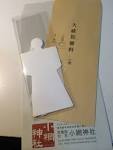 In this sense, great exorcism may be more meaningful than new year worshipping. In this sense, great exorcism may be more meaningful than new year worshipping.
There are also a number of shrines in Chuo-ku that perform this ceremony. In my case, I've been involved in this event at [Nazuki Shrine], [Tetsugunsu Inari Shrine] and [Koami Shrine]. All of them were wrapped in the dignity and strictness cultivated in history and tradition, and I felt somewhat tight.
 Why don't you visit a nearby shrine at the end of the year? Unlike the crowded grounds of new year worshipping, you can visit slowly. Why don't you visit a nearby shrine at the end of the year? Unlike the crowded grounds of new year worshipping, you can visit slowly.
Well, thank you very much for your help this year. I hope you have a good year.
[Yotaro]
December 26, 2013 09:00
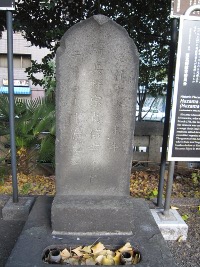 Speaking of Shiwasu, Ako Gishi was defeated, and at Kabukiza Theater, "Kanademoto Chushingura" ... one story related to Chushingura again this year. Speaking of Shiwasu, Ako Gishi was defeated, and at Kabukiza Theater, "Kanademoto Chushingura" ... one story related to Chushingura again this year.
I think many people know that one of the forty-seven men, the grave of Shinroku Hazama, is located at Tsukiji Honganji Temple. Of the forty-six people except Kichiemon Terasaka, who disappeared after the defeat, the only one Shinroku was buried outside Sengakuji. This is due to the fact that on February 4, 1703 (1703), Shinroku's son-in-law, Matasuke Nakado, who was the retainer of the late Akimoto Tajima Mamoru, took the remains from Mohri Kaimori's house where Shinroku was cut off and buried them at Tsukiji Honganji in the Chudo family Bodaiji Temple. (A tombstone will be built at Sengakuji on the 35th with other lawyers. posthumous Buddhist name is a friend of mine.
Shinroku has joined the debate with his father, Kibei (cut at Hosokawa Echinaka Mori's House) and his brother Jiro (cut at Kenmotsu Mizuno's House), so (only the three parents and children also participated.) .) There seems to be a direction that seems to be "Why only Shinroku?", But after the stomach was transported to Sengakuji Temple with a time difference in the order of Hosokawa, Mizuno, Matsudaira Okimori, and Mori family, Nakado Masuke finally went to the Hosokawa family of Kibei and the Mizuno family of Ju Jiro, but the body was already consideredMori family. In addition, it is reported that Shinroku tied Kaneko to a spear and put it in Honganji during the withdrawal of Sengakuji from Honjo Kira's residence, and asked for a memorial service, but it will be later story.
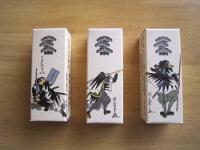 There is only one new six ... one other. The manners on the stomach was already formal at the time, and it is natural for an interrogator to drop his neck before cutting his belly, but it is said that Shinroku's assistant cut it into one letter before he shook his sword. It seems that he was a tough brother, called his brother, who was given the spear to Kira Uenosuke and was the most involved. There is only one new six ... one other. The manners on the stomach was already formal at the time, and it is natural for an interrogator to drop his neck before cutting his belly, but it is said that Shinroku's assistant cut it into one letter before he shook his sword. It seems that he was a tough brother, called his brother, who was given the spear to Kira Uenosuke and was the most involved.
The other day (the 14th), I went to the Gishi Festival at Sengakuji Temple, but there were more people than usual, so I could hardly reach the Gishi burial ground, so I gave up immediately and went to Tsukiji Honganji Temple and visited the quiet Shinroku grave.
[On the photo] The tomb of Shinroku at Tsukiji Honganji Temple, rebuilt during the Tenpo era. This posthumous Buddhist name is "Seishinshakumune Sadanobu".
[Lower photo] It was sold at "Gishi Yokan" in Shimbashi / Shinsho-do (close to the site of Tamura Ukyo Daio's House, where the inner Takumi was cut off, and famous for "in the middle of the stomach"), and at the B2F Kibikicho Square in Kabukiza . Left: Mashin Rokuro (black sugar): Kihee Hazama (salt) right: Jujiro Hazama (black sugar)
[Mr.Chuo-ku]
December 17, 2013 08:49
I think some people have finished writing New Year's cards and some will write them in the future. And I guess everyone is looking forward to the New Year's card that arrives during the New Year.
At the Nihonbashi Post Office in Chuo-ku, guests are invited on New Year's Day in recent years, and the New Year's Day Delivery Departure Ceremony is held.
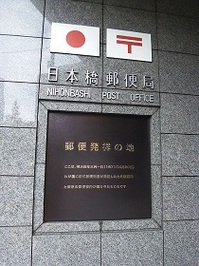 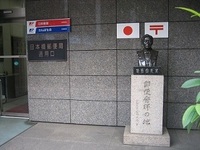
Nihonbashi Post Office was located in the place where the modern postal system began in 1871, where Ekiji (later the Ministry of Posts and Telecommunications) and Post Office (currently Tokyo Central Post Office) were established. There is a commemorative inscription and a bronze statue of Maejima, known as the "father of modern Japanese mail" (↑pictured).
It seems that the origin of the mail originated in Nihonbashi because of its excellent transportation convenience.
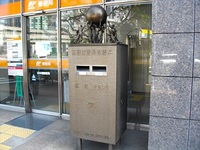
Post (Nihonbashi Post Office) was created to commemorate the 100th anniversary of postal service establishment.
By the way, the first post in Japan was established in 1871, and at that time it was called "Shojo Atsumebako", and the official name of the current post is "Yubinsashidashibako" It seems to be. You can see images of each post in ↓ (from "White Paper on Information and Communications, Ministry of Internal Affairs and Communications for Kids / Beginning of Modern Postal System")
http://www.soumu.go.jp/joho_tsusin/kids/history/3/02.html
Nihonbashi Post Office Map
http://map.japanpost.jp/pc/syousai.php?id=300101163000
[Ryokichi]
December 6, 2013 14:00
It was Thursday, November 28, but my work was off in the afternoon, so I visited the Doburoku Festival at Koami Shrine.
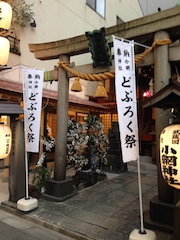
The Doburoku Festival is an event derived from the Niiname-no-Matsuri that appreciates the good harvest of new grains, and the Doburoku is served free of charge after being offered to God. The event will include the dedication of the national important village kagura dance in Intangible Folk Cultural Property, the lucky charm of protection against misfortune, and the award of the Shitamachi Mimizuku.
I was already calm because of the time being out of time, and I visited and had a doburoku. That said, it was a little gorgeous atmosphere in the music.
Koami Shrine is a small shrine located on a small site, but it has attracted attention as a festival in portable shrine in May, a festival in November, and a shrine in Fukurokuju and Benzaiten in Nihonbashi Seven Lucky Gods. It is an indispensable part of annual events around Ningyocho. The small shrine between the buildings has a very interesting structure. In front of the photo below, there is a little shrine hall in the back of the torii gate, a new shrine office on the left, a warehouse on the first floor, and a pentagonal Kagura Hall on the right.
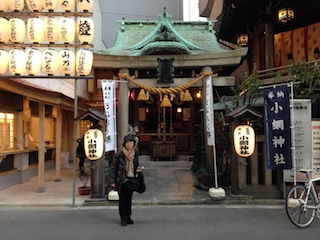
After completing the worship by hooking the doburoku, the downtown shopping street in Ningyocho spreads very close. The weather was so good that the cold had eased, but I felt so relaxed and wanted to stop by. However, it will be a different theme, so I would like to rewrite the times.
[Akira Makibuchi / Sharakusai]
09:00 on December 4, 2013
"Autumn Chuo-ku History Walk 2013-Walking the History of the Old Nikko Kaido-(2nd)" was held on the afternoon of November 30 (Saturday) in fine weather in late autumn. This historical walk visits the history of Nikko Kaido, which laid the foundation for the prosperity of Edo, from Nihonbashi to the site of Asakusa Gomon. Following the first half of the first half (November 16), the second half of the second half walked from the site of Temmacho prison to the site of Asakusa Gomon.
The recruitment of participants was recruited in the November 1 issue of the "News of the Ward" and was sponsored and implemented by the "Chuo-ku Cultural Properties Supporters Association", a town walking volunteer guide group.
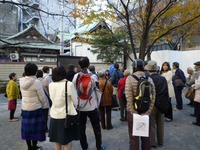 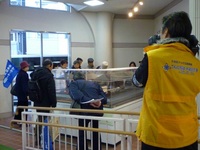
The number of participants who gathered at Jisshi Park reached the capacity of 30 people and departed in two groups (left photo). After observing a model of the Temmacho prison house at the Chuo-ku Machikado Exhibition Hall in Jushi Square (right photo = receiving TV coverage) and then look around the monument of the end of Yoshida Shoin in the park and the bell of Kokumachi. The road north of Daidenma Honcho-dori St. is the old Nikko Kaido. On both sides of the street are the former Tsunango-cho, and there was a Daimaru kimono store in the southeast corner crossing Daimon-dori until the late Meiji era.
Beyond that, the female scriptwriter Shigure Hasegawa was born and raised in the former Yuyu town. The Koshodo of Juzaburo Tsutaya has a shop facing the highway, and an explanation board is currently installed. In front of the diagonally, there is Tsuruya, a bookstore in Kyoto depicted in the Edo Famous Zoukai, and it is the area where the local wholesalers lined up. The fact that there were many hardware stores around here is detailed in Shigure Hasegawa's "Old Mon Nihonbashi". Even today, there are hardware companies from the Edo period.
After crossing the Hamacho River ruins, you will enter Yokoyamacho. It is the scenery of a wholesaler town where crowds are more crowded than usual before the end of the year. From the Bakurocho intersection, walk along Edo-dori St. During the Edo period, it was also an area where public and inns were lined up, and its bustle may have been the starting point of today. Further further, to the west, there is the ruins of the Baba of Hatsune. It is the oldest Baba, which is said to have been sold by Ieyasu, and has been featured in "Hundred Views of Edo" and "Edo Famous Zoukai".
There was a county mansion next to it. Litigators from Kanpachi came here. It is said that public inns and shops gathered in Bakurocho, and even a tourist information center for a four-day tour of Edo sightseeing appeared. When you follow the ruins of the Gundai mansion, you will notice a complicated path. Yasukuni Dori was built in the Great Kanto Earthquake Reconstruction Project and the block changed. Why was the border around here bent? It's a place to unravel. In this area, the site of the Gundai mansion was bordered by the ward.
Along the ruins of Yanagihara embankment, head to Saemon Bridge. This bridge over the Kanda River borders Chuo-ku, Chiyoda-ku, and Taito-ku. It is the northernmost part of Chuo-ku. Asakusa Gomon was placed in front of Asakusabashi. It was the last gate of the Edo Castle area when heading to Tohoku along the Nikko Kaido. Is it related to the fact that there is a police box near the Obansho at that time? It will be dissolved at the Asakusa Mitsuke Ruins Monument on the west side of Kitazume across Asakusabashi. @ Akira Makibuchi
◇The pattern of the town walk of the day, Chuo-ku TV public information "Hello Chuo-ku", is scheduled to be broadcast in the second week of December.
1
|
Links
|
 When Christmas is over, we're preparing for the New Year. It's a busy year for cleaning up, preparing New Year's dishes, and busy. And how would you like to spend New Year's Eve? People who are busy preparing for the New Year until the end, those who work during the year-end and New Year holidays, and those who spend a relaxing time ... each day looks back on the year.
When Christmas is over, we're preparing for the New Year. It's a busy year for cleaning up, preparing New Year's dishes, and busy. And how would you like to spend New Year's Eve? People who are busy preparing for the New Year until the end, those who work during the year-end and New Year holidays, and those who spend a relaxing time ... each day looks back on the year. Actually, there is another important traditional event on New Year's Eve. This is to visit great exorcism at the shrine. It is an important ceremony that removes everyday filth and entrusts wishes for the New Year together with "Nago Shinohara" on the eve of June. It has been held since the days of Nara and Heian. On this day, we will go through the Chinowa, which will cause trouble, and cleanse ourselves. And they dedicate a doll (persongata) by entrusting them to remove the filth on their behalf.
Actually, there is another important traditional event on New Year's Eve. This is to visit great exorcism at the shrine. It is an important ceremony that removes everyday filth and entrusts wishes for the New Year together with "Nago Shinohara" on the eve of June. It has been held since the days of Nara and Heian. On this day, we will go through the Chinowa, which will cause trouble, and cleanse ourselves. And they dedicate a doll (persongata) by entrusting them to remove the filth on their behalf. In this sense, great exorcism may be more meaningful than new year worshipping.
In this sense, great exorcism may be more meaningful than new year worshipping. Why don't you visit a nearby shrine at the end of the year? Unlike the crowded grounds of new year worshipping, you can visit slowly.
Why don't you visit a nearby shrine at the end of the year? Unlike the crowded grounds of new year worshipping, you can visit slowly.






